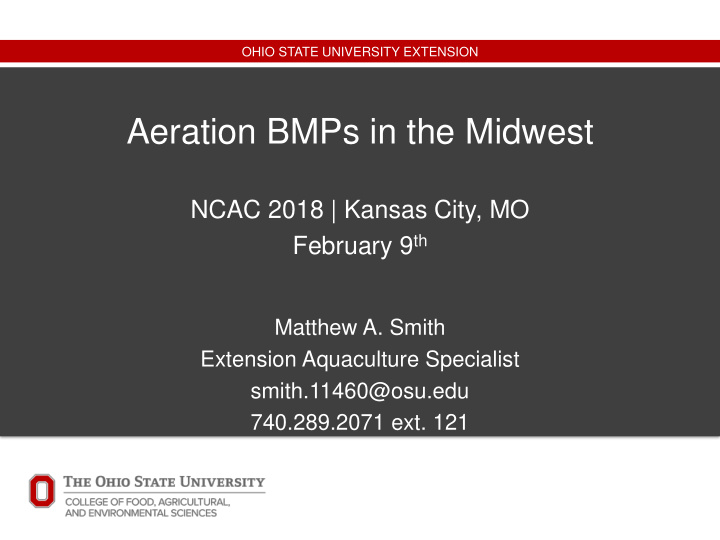



OHIO STATE UNIVERSITY EXTENSION Aeration BMPs in the Midwest NCAC 2018 | Kansas City, MO February 9 th Matthew A. Smith Extension Aquaculture Specialist smith.11460@osu.edu 740.289.2071 ext. 121
OHIO STATE UNIVERSITY EXTENSION Let’s just talk aeration… 2
OHIO STATE UNIVERSITY EXTENSION What are your goals? Feed the family? Hobby? Retirement money? Part-time? Full-time? Investor? Combination? Don’t really know? 3
OHIO STATE UNIVERSITY EXTENSION What are your goals? Your goals are going to tell you how much time and energy to invest in water quality management Small-scale hobby? Likely lower densities Less worried about survival and stress Lower feeding rates Money in and mostly enjoyment out Less stress on you 4
OHIO STATE UNIVERSITY EXTENSION What are your goals? Your goals are going to tell you how much time and energy to invest Full-time? Likely higher fish &/or plants More worried about survival/stress Higher (appropriate) feeding rates An investment Plenty of stress 5
OHIO STATE UNIVERSITY EXTENSION Stress 6
OHIO STATE UNIVERSITY EXTENSION Stress in humans | Acute vs. Chronic 7
OHIO STATE UNIVERSITY EXTENSION Stress in humans | Acute vs. Chronic 8
OHIO STATE UNIVERSITY EXTENSION Poor water quality makes life difficult Water quality testing is a tool in your toolbox A lot of stressers can be made tolerable if water is of high quality Poor water quality is often a trigger for something worse A compromised immune system invites other troubles! Limiting their stress with dedication to testing and recording goes a long way in ensuring the health of the animal 9
OHIO STATE UNIVERSITY EXTENSION Small fish | Big fish – oxygen consumption On a per/pound basis, smaller fish are going to consume more oxygen than larger fish Ex: 40 pounds of golden shiners will use up more oxygen than 40 pounds of tilapia 10
OHIO STATE UNIVERSITY EXTENSION Microbial community – oxygen consumption A lot of the oxygen that is consumed in a system is by the microbial community, detritus, and other organic matter Fish uptake is generally to a lesser extent Detritus, excrement, uneaten feed, etc. – only using up oxygen 11
OHIO STATE UNIVERSITY EXTENSION Water quality in culture systems A new system will require more attention than a well-established system – Why? High oxygen concentration (and saturation) is crucial Bacteria take time to establish A “seasoned” system will become more predictable, especially if you take could notes and maintain your records! Most parameters are interrelated! 12
OHIO STATE UNIVERSITY EXTENSION What happens when you feed in fish? 0.6 – 2.2 lbs 2.2 lbs Feed 0.4 – 0.9 lb Oxygen Alkalinity 0.8 – 3.0 lbs Carbon Dioxide 0.6 – 1.1 lbs 0.05 – 0.12 lbs Waste Solids TAN 13
OHIO STATE UNIVERSITY EXTENSION -Aerobic vs. anaerobic environments -Occurring in the presence of oxygen vs. occurring in the absence of oxygen … processes 14
OHIO STATE UNIVERSITY EXTENSION Types of aeration Best seen in action… What type of system? Where are you located? What are you doing? Ponds? Paddlewheels are king with bottom aeration extremely common in the NCR due to their ability to help de-stratisfy ponds Indoor you’ll find airlifts (utilizing airstones), airstones, specialized airlines, and sometimes pure oxygen 15
OHIO STATE UNIVERSITY EXTENSION Bubbles Greater surface area means greater diffusion into the water Something like paddlewheels…. Something like bottom bubblers… Same principle just applied differently 16
OHIO STATE UNIVERSITY EXTENSION Atmospheric vs. pure oxygen Almost always (great exceptions) atmospheric air used instead of pure oxygen in culture systems Nitrogen (~78%) & Oxygen (~21%) Almost always pure oxygen used when hauling fish 17
OHIO STATE UNIVERSITY EXTENSION Oxygen saturation ° F mg/L 32 14.6 41 12.8 50 11.3 59 10.0 68 9.0 77 8.2 86 7.5 95 6.9 18 Boyd and Tucker 2014; Handbook for Aquaculture Water Quality
OHIO STATE UNIVERSITY EXTENSION BMPs? Every system deserves a back-up generator Economically? Understand the risks associated with not having one Better at least have a back-up for indoor systems 19
OHIO STATE UNIVERSITY EXTENSION Example of protocols from USDA-ARS pub research Pond hybrid catfish study investigating min. oxygen concentrations Investigation into production characteristics between ponds that were allowed to reach low oxygen levels versus those kept at high levels Min 4.9 mg/l or 1.4 mg/l average Stocking catfish Feeding catfish: Luke Roy, Auburn Uni. 20 Feeding catfish: Luke Roy, Auburn Uni.
OHIO STATE UNIVERSITY EXTENSION Example from USDA-ARS pub research Dissolved oxygen affects on fish growth; Torrans et al. 2015 21 Feeding catfish: Luke Roy, Auburn Uni.
OHIO STATE UNIVERSITY EXTENSION Example from USDA-ARS pub research Dissolved oxygen affects on fish growth; Torrans et al. 2015 > Feed fed means > aeration required 22 Feeding catfish: Luke Roy, Auburn Uni.
OHIO STATE UNIVERSITY EXTENSION Example from USDA-ARS pub research Heard a lot over time… “ My fish are eating well and not dying. I must have enough oxygen for them so I don’t test.” Survival was the same (and never saw fish piping!) Similar responses not uncommon Test frequently Don’t waste energy Over aeration is costly and can even be stressful to the system 23 Feeding catfish: Luke Roy, Auburn Uni.
OHIO STATE UNIVERSITY EXTENSION Questions? Click to edit slide headline Matthew A. Smith Second level OSU South Centers • Third level smith.11460@osu.edu Fifth level 740.289.2071 ext 121 24
Recommend
More recommend